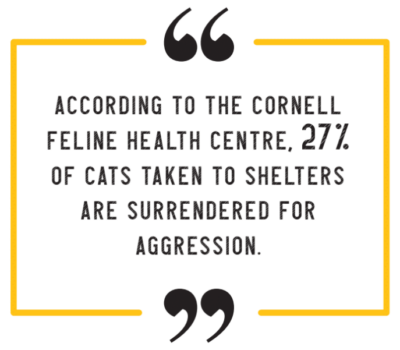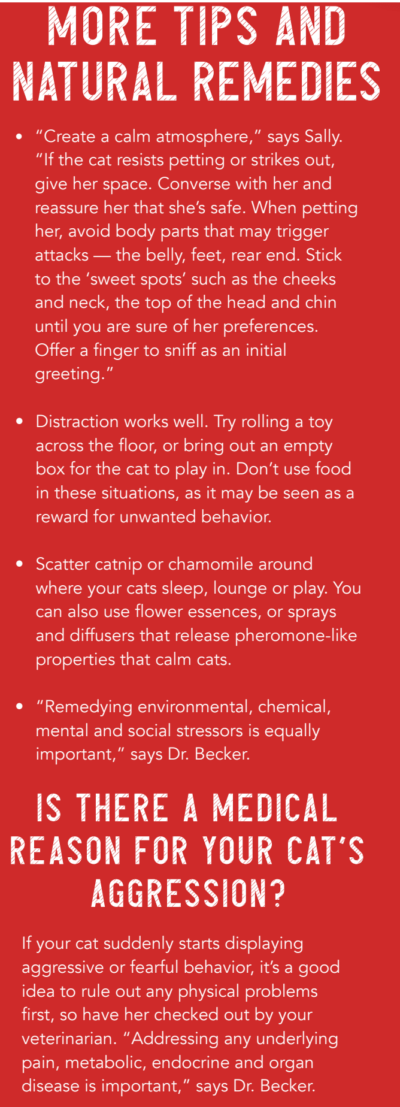
Our feline friends can sometimes behave aggressively. Whether it’s biting or scratching, or an all-out attack against another cat or person, aggression in cats can be upsetting and traumatic. But there’s always a reason for it — and solutions for defusing it.
Your kitty is curled up sweetly and you simply can’t resist stroking her. You think you’re both feeling content when she suddenly whips her head around and bites you, as if to say, “Go away!” In another scenario, two cats are sitting on the windowsill when one suddenly attacks the other for no apparent reason, triggering an all-out cat fight. Aggression in cats is fairly common, and this article looks at the different types and why they occur — and most importantly, what to do if your own cat is lashing out.
PETTING AND PLAY AGGRESSION
The most common types of aggression in cats arise from petting and play. According to the ASPCA, for example, repeatedly stroking a cat in one area can sometimes become unpleasant to her, and she’ll let you know about it by hissing, meowing, nipping or scratching, or sometimes just making a quick exit. During play, meanwhile, cats can get overstimulated and overexcited, and what starts as mock fighting can quickly escalate into the real thing.
What to do: Preventing these incidents means observing your cat and her responses to petting and play. Can you pinpoint something that is making her lash out?
“Learn her body language — ears pulled back, eyes dilated, lip licking, tail twitching — all can lead to sudden striking out if you’re not aware of the signals,” says cat behavior expert, Sally Bahner.
Equally important is not becoming irritated or angry in response to this aggressive behavior. “Instead, head off imminent attacks by tossing a toy to distract her,” says Sally.
FEAR AGGRESSION
If your cat is reacting aggressively to something else besides petting or play, and seems scared as well, she may be exhibiting fear aggression. It occurs when a cat feels threatened, and it can be difficult to determine what the cause is.
What to do: Knowing your cat’s history is very helpful in determining what she might be scared of, although this is difficult if you’re adopted an adult cat and don’t know her background.
“Identifying what physical, emotional and environmental triggers are contributing to a cat’s defensive or aggressive behavior towards humans or other animals is critical in formulating a therapeutic strategy,” says veterinarian Dr. Karen Becker. If you’re not sure what’s causing your cat’s fear aggression, think about any changes that may have occurred recently — loud noises, strange smells, changes in routine, or a new person or animal coming into the household could be contributing factors, for example. Minimizing or eliminating the trigger, wherever possible, will reduce the cat’s fear and aggression.
TERRITORIAL AGGRESSION
This is one of the most dramatic forms of aggression in cats. Signs to look for are  growling or biting when you or another animal approaches, along with spraying, scratching furniture and hissing. Territorial aggression is common in households with more than one cat.
growling or biting when you or another animal approaches, along with spraying, scratching furniture and hissing. Territorial aggression is common in households with more than one cat.
What to do: In a household of multiple cats, the Humane Society of the United States suggests you try reintroducing the newest arrival by keeping her separate from the others and slowly reintegrating her. Ensure there are enough bowls and litter boxes for all your cats, and be sure to spend positive time with them to encourage feelings of safety and security.
REDIRECTED AGGRESSION
This type of kitty aggression is related to something happening outside the house, rather than in it. Cats can become very fearful of noises, animals such as dogs or other cats, and even people outside your house. For example, you might not notice a stray cat walking across your lawn, but your own kitty can sense it. This can result in fights between household cats, urine spraying, and even attacks on human family members.
Redirected aggression can be especially difficult to deal with. In some cases, it may be temporary and can be sorted out. Unfortunately, however, some people can’t cope and surrender their cats to a shelter.
What to do: Block access to windowsills, close the curtains and provide more indoor stimulation in the form of play, toys, etc. Outside, spray window areas with a cat deterrent to drive strays or roaming cats away.
Understanding what triggers your cat’s aggression, while creating an environment that will encourage good behavior, is essential. You can also try a variety of natural remedies to help calm her (see sidebar at right). If your cat’s aggression persists despite your best efforts, however, it’s a good idea to consult your vet or a feline behaviorist. Patience and perseverance will pay off.
AUTHOR PROFILE

Nadia Ali
Nadia Ali is a freelance writer who was born in London, England and now lives on the Caribbean island of Trinidad. She is inspired by Cici, her family cat. Her work has been published online and in print.


